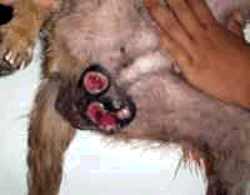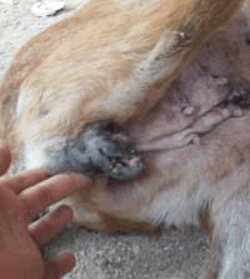Dogs wrestling in park

Photo courtesy of Depositphotos
Imagine a tumor that can be transmitted by touch. For dogs, this is not a matter of imagination; the transmissible venereal tumor has been described since 1876, and is not unusual where stray dogs roam free and have contact with one another. The tumor is found in both male and female dogs. Transmission is by simple physical contact between an existing tumor on one dog and abrasions on a mucous membrane (oral, genital, nasal, etc.) on another. It is most commonly spread during mating but can also be spread during routine sniffing or other contact. In most cases, tumor growth is found on the genitals, but it can also just as easily affect noses, mouths, anal areas, and other anatomical sites.
The transmissible venereal tumor, affectionately known as the TVT, may be visible as an external fleshy growth or may simply appear as genital bleeding (eventually, the tumor will become eroded on the surface). As mentioned, the tumor is common where there are large numbers of roaming dogs or in shelters. In most cases the tumor is not malignant and simply grows and bleeds at a local site and is eventually rejected by the patient’s immune system; however, resolution of the tumor can take over 9 months, which is a long time for a patient to bear a bloody infected growth. In approximately 10% of patients, the tumor does spread malignantly in a cancerous fashion though this is more likely in dogs that have an immunological compromise (young age, poor general health, concurrent other disease). Because of the long time to resolve and the potential for spread, treatment is generally recommended over simply allowing the tumor to regress.
Strangely, the tumor cells are not the patient's own cells transformed into cancer cells. This is not a matter of a virus being transmitted that causes normal cells to become cancerous. The TVT is actually a tumor that grafts itself from one dog's body onto another dog's body. Unlike the host's normal cells, TVT cells have a completely different number of chromosomes and do not originate from the host at all. Developing a TVT might be analogous to getting bitten by a mosquito, and the few mosquito cells left behind try to grow a new mosquito on the host's body.
Diagnosis is made either by biopsy (taking a small piece of tumor tissue for analysis) or by cytology (obtaining a smear of the tumor's cells and looking at it under a microscope, as shown above). The TVT is one of several tumors classified as a "Round Cell Tumor." Biopsy samples are more accurate, whereas a smear exam might only indicate that the growth in question is a Round Cell Tumor without being more specific.
Treatment
Treatment of the transmissible venereal tumor is straightforward and generally quite rewarding.

Before treatment. Photo courtesy of PhaNgan Animal Care.
Surgery
Surgery is not as effective as one would expect. In one study of 70 dogs, 22 percent had recurrence within 5 months. If a tumor is surgically removed and found to be a transmissible venereal tumor, one of the other treatment methods should ensue.
Vincristine
Vincristine is a chemotherapy agent that must be delivered intravenously. Intravenous (IV) catheters or butterfly units are placed to deliver the drug, as any spill into the tissue surrounding the vein results in a painful tissue slough (i.e., a chemical burn occurs). This, however, is the only serious risk in this treatment, and as long as proper IV materials are used, this complication is rare. The TVT responds after only one or two treatments, but generally, 3 to 6 weekly treatments are given to ensure a cure. There is some evidence that the treatment course is shortened when an appropriate canine non-steroidal anti-inflammatory medication (NSAID) is added to the regimen.
Doxorubicin
Doxorubicin, also called by the brand name Adriamycin, is another chemotherapy agent that must be given intravenously. It is a bit more intensive in its chemotherapeutic properties compared to vincristine but if vincristine is ineffective or yields only partial results, doxorubicin may be used to complete therapy.
Radiation

After only two treatments. Photo courtesy of PhaNgan Animal Care.
External beam radiation is effective in curing the TVT but is expensive and not readily available. If you are near a facility, however, this may be a good option.
This dog (called Fannie Mae) lived behind the Thong Sala market in Thailand and was fed by the people there. She contracted a transmissible venereal tumor in her wanderings. These photos show the tumor and the results after two vincristine treatments. See a more complete history of Fannie Mae from the PhaNgan Animal Care, Koh PhaNgan Suksa School, a non-profit organization based in Wok Tum, Koh PhaNgan, Thailand.